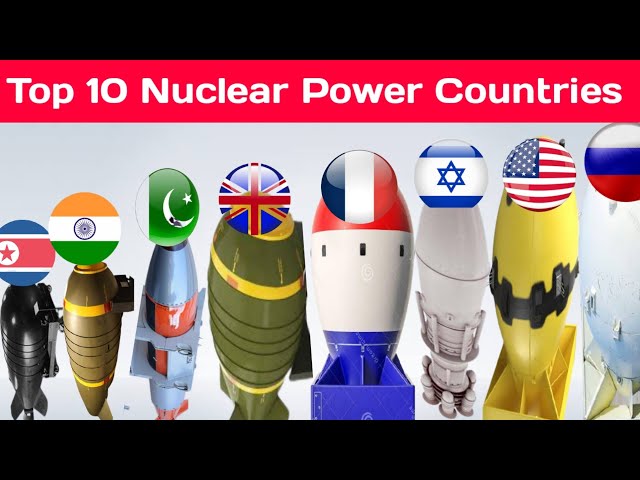 Introduction:
Introduction:
In an increasingly energy-dependent world, the quest for reliable and sustainable power sources has never been more critical. Among the array of energy options available, nuclear power stands out for its efficiency, low carbon emissions, and potential to meet the demands of a growing population. As nations vie for energy independence and seek to reduce their carbon footprint, the race to harness nuclear power has led to the emergence of several key players on the global stage. Here, we delve into the top ten atomic power countries, exploring their contributions to the nuclear landscape and their impact on the future of energy.
1. United States:
As the birthplace of nuclear power, the United States boasts the largest number of nuclear reactors in the world. With over 90 commercial reactors spread across the country, nuclear energy accounts for approximately 20% of the nation's total electricity generation. Despite facing challenges such as aging infrastructure and regulatory hurdles, the U.S. remains a powerhouse in the nuclear arena, driving innovation and technological advancements in reactor design and safety protocols.
2. France:
Renowned for its extensive nuclear program, France relies heavily on atomic power to meet its energy needs. With 56 reactors in operation, nuclear energy contributes around 70% of the country's electricity supply, making France one of the most nuclear-dependent nations in the world. The French government's long-term commitment to nuclear energy, coupled with robust safety standards and waste management practices, has solidified its position as a leader in the global nuclear industry.
3. China:
In recent years, China has emerged as a frontrunner in the race to expand nuclear power capacity. With ambitious plans to reduce carbon emissions and transition to cleaner energy sources, the Chinese government has invested heavily in nuclear infrastructure, rapidly constructing new reactors and modernizing existing ones. Currently, China operates over 50 nuclear reactors, with dozens more under construction, signaling its intent to become a dominant force in the global nuclear arena.
4. Russia:
With a long history of nuclear expertise dating back to the Soviet era, Russia remains a key player in the atomic power sector. The country operates 38 commercial reactors, supplying roughly 20% of its electricity needs. In addition to its domestic nuclear program, Russia is actively involved in exporting nuclear technology and services to other countries, further solidifying its influence in the international nuclear market.
5. Japan:
Despite the setbacks caused by the Fukushima Daiichi nuclear disaster in 2011, Japan continues to be a significant player in the global nuclear industry. Prior to the accident, nuclear energy accounted for approximately 30% of Japan's electricity generation. While the country has since scaled back its reliance on nuclear power and implemented stricter safety regulations, it still operates a sizable fleet of reactors and remains committed to nuclear energy as part of its energy mix.
6. South Korea:
In recent decades, South Korea has made significant strides in developing its nuclear energy capabilities. With 24 reactors in operation and several more under construction, nuclear power plays a vital role in meeting the country's energy demands and reducing reliance on imported fossil fuels. South Korea's commitment to nuclear energy innovation, coupled with its stringent safety standards and robust regulatory framework, positions it as a key player in the global nuclear arena.
7. India:
As one of the world's fastest-growing economies, India faces the dual challenge of meeting rising energy demand while reducing carbon emissions. Nuclear power has emerged as a crucial component of India's energy strategy, with the country operating 22 reactors and plans to expand its nuclear fleet in the coming years. India's indigenous nuclear program, coupled with strategic partnerships with other nuclear nations, underscores its commitment to leveraging atomic power for sustainable development.
8. Canada:
With its abundant uranium reserves and long-standing expertise in nuclear technology, Canada plays a significant role in the global nuclear landscape. The country operates 19 commercial reactors, primarily in the provinces of Ontario and New Brunswick, where nuclear energy contributes a substantial portion of electricity generation. Canada's commitment to nuclear safety, research, and innovation positions it as a trusted partner in international nuclear cooperation efforts.
9. United Kingdom:
The United Kingdom has a rich history of nuclear power dating back to the 1950s, with nuclear energy currently accounting for around 20% of the country's electricity generation. While the UK's nuclear fleet has undergone decommissioning in recent years, plans are underway to replace aging reactors with new, advanced designs. With a renewed focus on nuclear innovation and sustainability, the UK aims to maintain its position as a leader in the global nuclear renaissance.
10. Germany:
Rounding out the top ten atomic power countries is Germany, which has undergone a significant energy transition in recent years. Following the Fukushima disaster, the German government announced plans to phase out nuclear power completely by 2022, citing safety concerns and a commitment to renewable energy. Despite this decision, Germany's nuclear legacy and expertise continue to influence global nuclear policy and technology development.
Conclusion:
The top ten atomic power countries play a pivotal role in shaping the future of nuclear energy, driving innovation, and influencing international policies and practices. As the world grapples with the challenges of climate change and energy security, nuclear power remains a vital component of the global energy mix, offering a reliable, low-carbon source of electricity. By harnessing the collective expertise and resources of these leading nations, we can pave the way for a sustainable and prosperous energy future.



You must be logged in to post a comment.